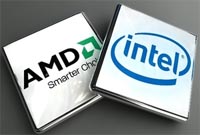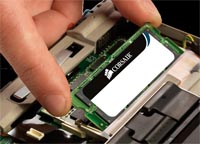Power, Processor and Memory
 Most users rarely come close to using the full power of their PC’s processor (CPU). There are several types of processors found in modern laptops:
Most users rarely come close to using the full power of their PC’s processor (CPU). There are several types of processors found in modern laptops:
- Low-end (cheap) processors which are fine for basic use (e.g. Intel Celerons)
- “ULV” or ultra-low-voltage chips which use very little power and need less cooling but have less processing power overall
- Mid-range processors (e.g. Intel Core-i5 Mobile) which offer a balance between power consumption and performance
- High-end processors (e.g. Intel Core-i7 quad-core processors) which use more power but offer faster performance (and also generate more heat). Some have two cores, some have four; the more cores can use more power but are capable of more concurrent processing, this is useful for programmers, designers, developers, power users and gamers
- Laptops which desktop chips in them – these are not as common any more but still exist, they use desktop CPUs to deliver more processing power but use more electric power and require more cooling as a result. They are more likely to be found in larger systems and some gaming machines
Most people won’t require as much processor power unless they are running tasks which are more intensive, e.g. they are doing heavy graphical work or are running share market trading simulators or virtual machines. Your needs will be determined by what you use the machine for; if it’s used as a “satellite” machine (you have a main desktop at home and use this for mobile use only) then you often can afford to go for something with less direct power as the “heavy lifting” is done by the desktop at home.
To find out what you’re going to need look for recommendations based on the software you’re going to be using; if you’re using something special or unusual it may stipulate greater requirements or run significantly faster if you have a powerful processor however if you buy something too powerful and don’t use it you’ll just waste money and may have to compromise on weight, battery life and size unnecessarily.
Memory
 As a baseline you’ll need at least 8 gig of RAM – some laptops still ship with 4 gig of RAM but this simply isn’t enough these days. Many machines are not expandable – you can’t add more memory to them later – so you are stuck with whatever you bought in the first place. This is a big problem if you “under-buy” as you’ll be stuck with slower performance, more restrictions and more instability and you won’t be able to do anything about it down the track.
As a baseline you’ll need at least 8 gig of RAM – some laptops still ship with 4 gig of RAM but this simply isn’t enough these days. Many machines are not expandable – you can’t add more memory to them later – so you are stuck with whatever you bought in the first place. This is a big problem if you “under-buy” as you’ll be stuck with slower performance, more restrictions and more instability and you won’t be able to do anything about it down the track.
Typically smaller machines and Ultrabooks are not expandable – it depends on the manufacturer. Some brands offer models that are significantly more expensive for a bit more memory; you have to be very careful.
If you are running something that requires a lot of memory (e.g. virtual machines) then you may need to buy a machine that has a lot more memory installed or can be easily upgraded; larger machines usually have expansion sockets that can be accessed (often called “SODIMM” sockets), this depends on the brand and the model. Some have only one, others have two; look into this and find out what the machine has. Also look at the machine’s upper-memory limit – some have two sockets but they won’t recognise more than 8gig of RAM even though you could easily buy and insert two 8gig SODIMM modules; the laptop is designed to only use a maximum of 8gig of RAM in that case. Be extremely careful of machines with this limitation.
It pays to find out precisely what can and can’t be done with that particular machine – look for the specific model number and find out what is available. For better information on most models there is an excellent memory information database online provided by Crucial (a memory company) – this can be found at http://www.crucial.com/usa/en/memory-info and will give you specific technical information on the memory that can be used with your particular laptop.